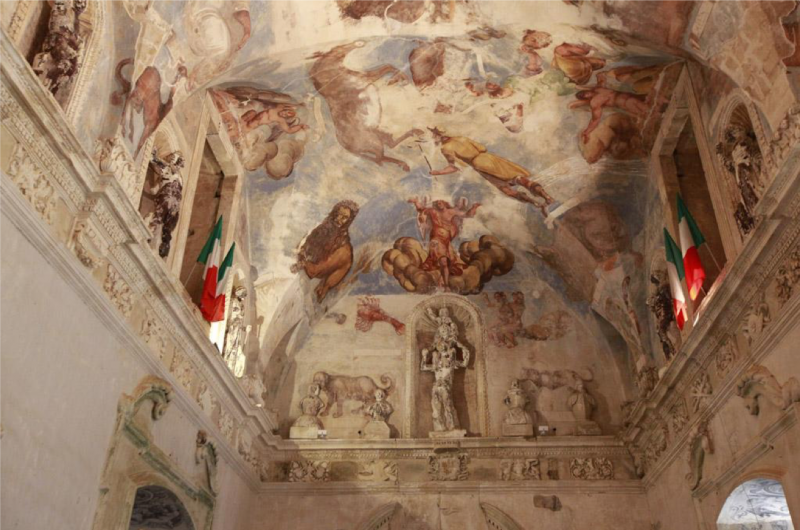Galleria del Castello Ducale Castromediano di Lymburgh a Cavallino di Lecce. Image in the public domain.
The galleria at the ducal palace of the Castromediano di Lymburgh in Cavallino gathers fresco painting and sculpture that offer an allegorical panorama.
The fresco on the ceiling depicts the zodiac, while niches high up in the walls house different sculptural personifications of the Moon, the Sun, Mercury, Saturn, Mars, Venus, and Jupiter, as well as of spring, summer, autumn and winter. At the center of the room stands a water fountain representing abundance. Along the walls there are allegorical sculptures: tempus, natura, splendor, paupertas ingeniosa, iudicium humanum, virtus heroica, furor, clementia, ingenium, dolor e rumor, furor poeticus, veritas, sapientia, honor virtutis, occasio and abundantia. Higher up in the walls, there are portrait sculptures of Castromediano family members: Francesco Castromediano, Marquess of Cavallino (1598-1663) and his wife Beatrice Acquaviva d’Aragona (1603-1637); Francesco’s parents, the baron Domenico Ascanio de Castromediano (1568-1628) and his wife Aurelia Sanseverino (1578 - ?); and Francesco’s sons: Domenico Ascanio, Duke of Marciano (1629-1697), Giovanni, Abbot of San Giorgio (1630- ?), Geronimo (1637- ?), fra Tommaso (1632-1698), and fra Giovanni Battista (1631-?) Knight of Malta. There also stands a portrait of the mythical hero Aeneas, whom the Castromediano presented as ancestor of their lineage.
The gallery has its origin in the first half of the seventeenth century with the reconstruction of the palace (1627-1637), which took place after the wedding between Francesco Castromediano and Beatrice Acquaviva d’Aragona in the summer of 1627. The next year, 1628, was also memorable as king Philip IV of Spain granted the Castromediano the title of marquis, and Francesco became the first Marquess of Cavallino, holder of feudal territory.
Duke Sigismondo Castromediano’s autobiography of 1895 describes the gallery and identifies Francesco Fiorio di Messina as the sculptor and author of the frescoes; by contrast, a 1663 inventory names Carlo d’Aprile from Palermo as the author. Mario Cazzato has identified Antonello della Fiore as the painter of the ceiling; della Fiore was in the service of Castromediano by the 1630’s.
It is probable that the iconographical program presents an allegorical history of the house of Castromediano. Angelo Maria Monaco proposes that the relationship between the astrological representations in the fresco and in sculpture has its literary base in the catasterismi from Hyginus’s De Astronomica (first century AD). Giovanni Pozzi interpreted the fountain as a pun on the name of Francesco’s wife—Acquaviva—exalting the image of prosperity under the new marquisate. As Francesca Canella observes, branches of the noble Acquaviva family—scattered in Southern Italy—frequently employed the symbolism of “living water” as a marker of the importance of the family for the spread of culture in the region. Attention to the use of analogies and metaphors is key to understanding the program in its relation to the intense cultural development of Cavallino during the first half of the seventeenth century, as well as the development of the forms that helped shaping the figurative language of the southern baroque.
One feature that stands out in the program is that the sculptures higher up in the walls are black. The material for all the sculptural work is pietra leccese, a local limestone whose porous quality led the artisans to cover it with a white slip (latte di calce) in an attempt to seal and protect it. Sigismondo Castromediano first noted the color of these pieces, and explained they were whitened in the nineteenth century, while Jean Louis Desprez affirmed that a blackening of the original white figures took place. Raffaele Casciaro confirms that a black color shows up underneath the white layer. For Monaco, the rarity of this treatment could be part of the intended effect, and he proposes that the humanist Ascanio Grandi’s poem “La Vergine Desponsata” provided the literary base for the whole artistic program. This makes reference to the work of a painter who, following the Creator, attempts to depict the sky, and it also mentions sculptures of humans with black skin, darkened by the light of the zodiac. It is possible, on the other hand, that the blackening of the sculpture was meant to simulate bronze. A scientific examination of the material could confirm either hypothesis.
Another remarkable aspect is the probable portrayal of a horoscope in the ceiling. The location of the planets in the zodiacal cycle suggests the indication of a specific date. Were that the case, the program would mark a period during the summer, which then could relate to various eventful experiences of the family over the years, considering that the gallery was developed under Francesco’s and Domenico Ascanio’s rule. Further inquiries on the astrological images could delineate a specific occasion to which the program might refer.
July 1, 2019
Bibliography
Cannella, Francesca. "The Ephemeral Baroque of the Exequies for Beatrice Acquaviva D'Aragona (Cavallino-Lecce, 1637)." Music in Art 37, no. 1/2 (2012): 101-10.
Casciaro, Raffaele. “Precisazioni sull’attività di Carlo d’Aprile nel castello dei Castromediano a Cavallino.” In Dal castello al palazzo baronale: Residenze nobiliari nel Salento dal XVI al XVIII secolo, edited by Vincenzo Cazzato and Vita Basile, 286-93. Galatina: Mario Congedo, 2008.
Castromediano, Sigismondo. Memorie del duca Sigismondo Castromediano. 1895. Edited by Marta Pierri. Edizioni digitali del CISVA, 2010.
Cazzato, Mario. La Galleria Celeste: Astrologia e Arte alla Corte dei Castromediano di Lymburgh nel Castello di Cavallino. Galatina: Mario Congedo, 2016.
Cazzato, Vincenzo. “Ingressi trionfali e teatri di morte: Momenti dell’effimero fra Cinque e Ottocento nella Puglia meridionale.” In Le capitali della festa: Italia centrale e meridionale, edited by Marcello Fagiolo, 360-76. Rome: De Luca, 2007.
Garrisi, Antonio. I Castromediano feudatari di Cavallino. Lecce: AGM, 2003.
Grandi, Ascanio. La vergine desponsata. Lecce: Pietro Micheli, 1639.
Grasso, Fabio Antonio. “Carlo D’Aprile a Cavallino: La fontana seicentesca nella Galleria del Palazzo Castromediano.” Spagine della Domenica, March 15, 2015, 18-19.
Infantino, Giulio Cesare. Lecce Sacra. Lecce, 1634.
Monaco, Angelo Maria. “L’oroscopo delle nozze dei marchesi nel salone astrologico dei Castromediano di Lymburgh a Cavallino di Lecce: Proposte iconologiche, aspetti iconografici e documenti inediti.” In La “Galleria” di Palazzo in età barocca: Dall’Europa al Regno di Napoli, edited by Vincenzo Cazzato, 236-45. Galatina: Mario Congedo, 2018.
Monaco, Angelo Maria, “Le favole dei poeti antichi sopra i segni dello zodiaco: Arte e astrologia nella galleria di Palazzo Castromediano di Lymburg a Cavallino di Lecce.” In Il Medioevo dopo il Medioevo: Iconografie, tipologie e modelli; Atti del convegno internazionale di studi (Lecce, 10-12 maggio 2012), edited by Raffaele Casciaro, 79-117. Lecce: Edizioni Esperidi, 2016.
Pozzi, Giovanni. Sull’orlo del visible parlare. Milan: Adelphi, 1993.
Valzano, Virginia, Fabio Negro, and Riccardo Foschi. “The Gallery of the Castromediano’s Castle: Three-Dimensional Reconstruction and Virtual Representation.” SCIRES-IT 7, no. 2 (2017): 13-26.


